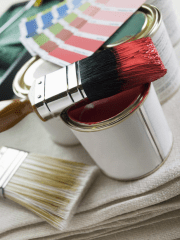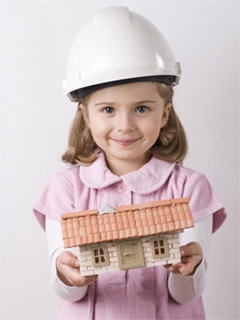 Do you have trouble picking the right colors when it’s time to repaint the outside of your home? Does the thought of choosing the wrong colors scare you silly? The dizzying array of color choices is enough to give a homeowner a case of chromo phobia, the fear of colors. How do you decide what colors to use when there are so many options?
Do you have trouble picking the right colors when it’s time to repaint the outside of your home? Does the thought of choosing the wrong colors scare you silly? The dizzying array of color choices is enough to give a homeowner a case of chromo phobia, the fear of colors. How do you decide what colors to use when there are so many options?
At $50 a gallon or more for quality exterior latex, you can’t afford to make a mistake. And if you don’t like the colors, your neighbors probably won’t either; colors have public impact — you’re not the only one who has to live with them. But a little research and planning can help you get started with the confidence that the final paint job is one that you – and your neighbors — will be pleased with.
But don’t just take your painter’s suggestions, and don’t chicken out by choosing the same colors as the house down the street. Get past the fear with these simple steps for figuring out how to give the outside of your home the perfect new look.
Field, Trim, and Accent
An existing house isn’t a blank canvas – after all, you’re not changing the color of the roof, the brick or stone, and maybe not even the windows (if they’re vinyl or aluminum clad). Roofs and masonry walls are large areas of unbroken color and natural starting points for creating a palette.
An exterior paint scheme should be made up of at least three colors: The field, or large areas such as walls or roofs. The trim, which is corner boards, window trim, fascias, rakes, etc. The accent or specific elements including: doors, shutters, and other architectural features.
Field colors make up the majority of what you’ll see on the house and will lead you to the choice of trim and accent.
Are you trying to make your house look a little more prominent on the street? A lighter field color will make it look larger; a darker color will visually shrink it. Lighter colors can also make a house look visually flimsy, while darker colors can give it a strong, solid appearance.
But it’s the trim color that can make or break the scheme. Painting the trim the same color as the field can work in some cases, but it can also give the house an “unfinished” or “wedding cake” look. Darker trim – especially around the windows – can cause a “frame” effect, where the windows look like pictures hung on a wall. Keeping the trim lighter than the field is almost always a safe bet. Gutters, downspouts, and similar elements should usually be painted the trim color to help them “disappear” into the background.
The accent color is where the excitement is. Once you’ve chosen an attractive combination of field and trim, make it “pop” with an eye-catching accent color. It’s a tool to give life to an otherwise muted color scheme and draws attention to the important features of the house. The front door, shutters, and the windows frames (not the trim) are good places for accent colors. Windows painted with accent and trim colors together can be the most interesting part of the composition.
Match The Paint Scheme To The Style
The two most important considerations in choosing a color scheme are the architecture of the house and the neighborhood context. Historic architectural styles, for example, look best in their original color schemes, although these can vary quite a bit. Original Colonial and Colonial Revival homes were often quite colorful on the inside, but less so on the exterior.
Often they were painted in a single color for the field and trim, with a second color for an accent. Combined with prominent red brick chimneys and a brick or stone base, the effect is a three-color scheme.
Victorian homes – often referred to as “painted ladies” – sometimes showed off six or more colors of trim and accent. Making that look good today takes the services of a color specialist and a lot of time. But a similar effect can be had with as little as three colors if they’re well placed on the house.
The Craftsman style of the early 20th Century sported a darker, earthier color scheme using deep browns, greens, and reds. The current popularity of the style is making more homeowners consider richer color schemes for their homes.
There are TONS of resources available for seeing examples of historically-accurate house colors – take advantage of those. Also take cues from the other houses in your area – a house should have its own personality and style, but houses don’t look good in “party dress” all the time.
Final Coat
Every color choice must be tried out on the house – don’t ever buy a gallon of paint from the color chip alone! Most paint stores offer quarts of paint at reasonable prices so you can try out several colors or color combinations before you commit to a scheme.
Get a couple of paint decks (those color wheels that fan out) from a couple of paint manufacturers to get started. Narrow your choices down to two or three paint schemes, then buy a quart of each color – and a quart of several other colors that are nearby on the color strips.
Here’s why: Colors that look great on the color strips don’t always look so great on the walls — and you’ll never know until you try them out! Often, darker colors look much lighter on the house, so always get a quart of colors at least one tint lighter than your first choice (“tinting” makes a color lighter; “shading” makes a color darker.)
Leave the colors samples up on the wall for several days before you choose. Look at the color in sunlight and in shade, morning and evening. The larger the area you paint, the easier your choice will be!
Whether you’re comfortable with choosing colors or not, you have several resources that can make the decision much easier. Many paint manufacturers have produced pre-selected color palettes arranged byarchitectual style or color range that specify compatible field, trim, and accent colors. They’re available at paint and building supply stores and many are very well done. Many paint companies have online paint selection programs that suggest proper color combinations – some even allow you to preview colors on photographs of real houses, or on a digital photo of your own home.
Plan ahead, be bold in your color choices, and try colors on the house first. You’ll be thrilled when your house has a fresh, exciting new look! Who said watching paint dry is no fun?
As a Design+Build General Contractor, I offer my clients a one-stop shopping approach to all of their home remodeling projects. I work with my clients from initial conception of a project through its completion. Every aspect of the job is managed by me and my professional crew. You will be included in every step of the design process until the final drawings are completed. No detail is left to chance. General Contractor Specializing in Kitchen & Bathroom Design and Remodeling Throughout the Los Angeles area.
Written By:

Offer Steuer
President
OTM Designs & Remodeling, Inc.
For more information you may contact us via email at service@otm1designs.com or you may call us at 888-981-1415. Our website is www.otm1designs.com.


